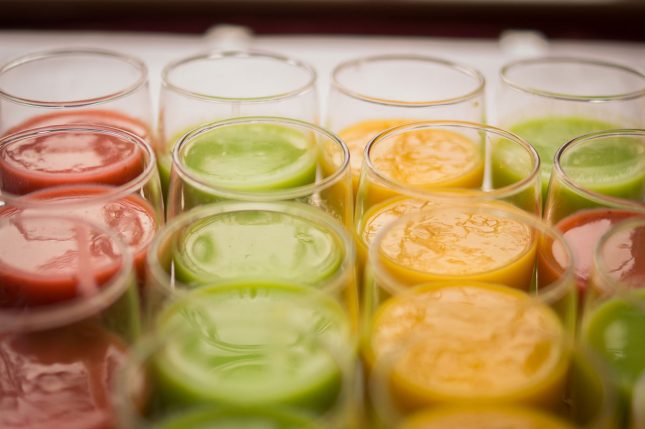Every day there’s a new report of yet another study telling us what we should or shouldn’t eat. With so many conflicting ideas working out the optimum nutrition for you and your family can be downright confusing!
There are such a lot of different models for ‘healthy nutrition’ or ‘healthy eating guidelines’ – such as the Food Pyramid – all supposedly to guide us make the right choices.
But even the well-established Food Pyramid keeps changing, so how can you make sure you get the right balance of quality nutrients for growing your family?
A diet rich in nutrient-dense foods is essential for building healthy families with strong immune systems to ward off the myriad of potentially harmful bacteria and viruses we are exposed to on a daily basis. This is especially true for the young ones who need to build their resistance to cope with the nasties they are bombarded with, while at the same time providing them with the necessary building blocks to grow strong bodies.
Good nutrition isn’t just about what we eat but also encompasses how we eat and the environment in which we consume our food. Simple things like chewing your food well, taking time to ingest and digest, and eating together at the table, are not only ideal for enhancing good digestion and optimal absorption of nutrients but also helps build strong family bonds.
Research has shown that in children aged between 3 and 12 years old, time spent eating at home came up trumps in terms of academic success – making a bigger difference than school, homework, sports, art and religion. Eating together as a family is one of the most important parts of finding optimum nutrition for your family.
But it’s not easy. Not only do parents work more hours now than ever before but children are busier too, with structured out-of-school activities. As a result families spend less quality time together. So make eating together as a family your number one goal for more quality family time. And make sure those meals nourish your family for ultimate wellbeing.
Guiding Principles and how to eat the rainbow
– Eat a rainbow of fruits and vegetables everyday. We think 5+ a day is only just adequate – for great health we should be centering our diets around vegetables and fruit (in that order!) and aiming for up to 8 servings a day.
– Aim for one raw salad, leafy green smoothie, or “raw” meal each day to ensure you are getting your 8 servings plus enough enzymes (which help ensure good digestion) from the food you eat. Many nutrients are destroyed by cooking, including vitamin C, folic acid and enzymes.
– Eat in season to optimise a broad variety of foods in your daily life. You can gorge on strawberries and asparagus in the spring, and stock up on nuts and root vegetables in the winter.
– Favour whole grains over processed every time to get the best from flour, pasta, bread, cereals and rice.
– Buy organic. In an ideal world all our food would be produced without toxic chemicals. Purchase organic meat and poultry where your budget allows, then organic fruit and vegetables – or grow your own lettuce in a small garden or in tubs – the fancy red lettuce is surprisingly hardy and easy to grow all year round in most parts of the country. Studies show that the nutrient content of organically grown foods is higher than that of non-organically grown foods, and of course it’s free of those potentially harmful toxins.
Foods to provide your family with optimum nutrition
Make sure your food is fresh and includes plenty of:
– Leafy, green vegetables, which are rich in minerals and vitamins. Select from broccoli, water cress, silverbeet, spinach, lettuce, kale, Brussels sprouts and sea vegetables (such as karengo and nori).
– Purple and red fruits and vegetables contain an abundance of antioxidants and flavonoids. Enjoy beetroot, purple kumara (skin on), blackcurrants, blueberries, strawberries, guavas, cherries, fresh cranberries, grapes, raspberries and goji berries. Pomegranate fits into this category too.
– Yellow, orange & green fleshed vegetables and fruits are rich in carotenoids, plus vitamins A and C. Get plenty of them from carrots, pumpkin, tomatoes, beans, capsicum, avocados, persimmon, feijoas, apricots, kiwifruit, citrus and tropical fruits.
– Whole or minimally processed grains and pulses. These are abundant in essential fibre, protein, vitamin B and nutritional oils. Good sources are oats, amaranth, barley, buckwheat, quinoa, rye, wheat, spelt, lentils, chickpeas, black beans, kidney, adzuki and haricots beans.
– Nourishing nuts and seeds are rich in good quality fat, protein, minerals (including calcium), vitamin E and soluble fibre. Reach for a mix of almonds, Brazil nuts, cashews, hazelnuts, pine nuts and raw peanuts. Ideal seeds are alfalfa (sprouted), linseed (flaxseed), Chia, pumpkin, sunflower and sesame seeds. Nut-allergic people may be able to tolerate some of the seeds.
– Fresh herbs such as basil, coriander, thyme, dill, parsley, rosemary and sage are very rich in vitamins, minerals, natural oils and may also have digestive and immune-enhancing properties.
– Spices are concentrated sources of minerals and vitamins, and many have anti-microbial and anti-inflammatory properties. There are many to choose from – cardamom, chilli, cinnamon, coriander, cumin, garlic, ginger, tamarind and turmeric, just to name a few.
– Dried fruits should be used in moderation – apricots, figs, currants, dates, prunes and raisins – while containing soluble fibre, vitamins and minerals, they are a very concentrated source of carbohydrates (sugars).
How to incorporate optimum nutrition into daily family life
- Make a wholesome breakfast an essential start to everyone’s day. Keep its simple and vary it from day to day. If you are strapped for time, the best “fast food” breakfast is a vitamin and mineral rich, daily green smoothie that you can throw in a robust blender and whip up in a few minutes. Varying it is easy, given the range of fresh fruit, nuts and seeds available. Add fresh greens (such as spinach or lettuce) and water. Kids love these because you can add extras like natural yogurt and their favourite fruit and you can vary it as often as you like. Smoothies are really tasty, easy to get down the hatch and are a great start to the day. You can serve them in a fun glass or special drink bottle or use a funny straw to add some adventure. What a great way to get the good stuff in!!
- Don’t skip meals. Skipping meals can create internal stress, playing havoc with blood sugar control. Consequently energy levels and cognitive function may be compromised. Erratic eating also lead to poor bowel function, food cravings and over eating. However, neither is it sensible to eat unless you’re hungry. If a lack of appetite is a problem for you (this is surprisingly common in the morning), then a visit to your natural health practitioner is in order. Include a simple nourishing morning or afternoon snack only if needed – growing children and very active adults may need a snack, but most people don’t.
- Eat smarter and opt for more quality ingredients over quantity. For example when making muffins choose whole grain flour over white. Use xylitol, stevia, honey or fresh fruit purée to sweeten rather than energy-dense but nutrient-void white sugar. It is far better for your body to have smaller amounts of nourishing food than consuming large amounts of cheap, poor quality foods.
- Manage your portions by using the palm method – the size of your palm for quality lean protein, (organic chicken or meat, fish or shellfish, legumes & pulses, tofu/tempeh), your index and middle finger for the portion of quality fats, (avocado, 1st pressing culinary oils, nuts and seeds), and your whole hand, palm and fingers, to measure your lean carbohydrate portion, (vegetables, leafy greens). Adults should limit themselves to 1-4 tablespoons of starchy carbs like potato, brown rice, or whole grains, wholegrain pastas or bread per meal. For weight loss, this food group can be skipped altogether, while children and active adults may need the larger serve. Add a single portion serve of “sweet” if desired.
- Fat Control – Although nuts, seeds, coconut and avocados are high in fat, these are the types of fat that are really important for good health. Eat up to a handful a day, 5 -6 days a week of a variety of raw nuts and seeds (sprinkled on cereal or vegetables and salads or as part of a snack). Include small servings of avocado regularly – it is a great quality food to be enjoyed in moderation.
Use coconut oil, extra virgin olive oil, avocado oil, nut oils like hazelnut or walnut, pumpkin seed oil and flaxseed oil. Nut and seed oils should be kept cool (some are best in the fridge). Coconut, olive and avocado oils can be used for cooking but the rest are best added in small amounts after cooking in small amounts to avoid damaging them. Trim the fat off meat before cooking and remove the skin from chicken (fish skin however, is coated in good fat).
- Read labels – the nutritional panel on packaged foods tells you the amount of fat, protein and carbohydrates in a product, but also important is the ingredients listing – how many of those things listed look like chemical names?
- Avoid fried and deep-fried foods.
Try water frying (see below) instead of using oils where possible – see inset. Be wary of table spreads and margarines – many are stacked with damaging trans-fats.
- Enjoy fish, 3-4 times per week. Oily fish in particular is high in omega 3 – great nourishing great brains, keeping skin healthy, as well as assisting in reducing inflammation, managing cholesterol and regulating weight. Include salmon, sardines (canned in spring water), fresh tuna (not more than 1-2x per week), trevally, kingfish, mussels, squid and kahawai.
- Eat real food. An incredible amount of what we have available in the supermarket is food that our ancestors would probably not even recognise as food. Concentrate your food shopping on the fresh food departments.
Food equation table
If you are stuck for ideas on how to go about getting all the goodies into a meal use the food equation table below, especially helpful for designing kids lunches and dinners. Experiment with it for healthy meals or snacks and use it to teach your children how to recognise and plan a well-balanced meal.
Carbohydrate + Protein + Quality Fat + Lean carbohydrates + ‘Crunch’ (+ Sweet*)
| Carbohydrate | + Lean Protein | + Quality Fat | + Lean carbohydrates | + ‘Crunch’ | (+ Sweet optional) |
| 1-4 Tablespoons (amount depending on activity or growing status) | Palm size | Index finger |
Whole hand |
1 serve = palm of hand or 1T dried fruit. | |
| Wholegrain wrap Wholegrain pita Wholegrainbread Mountain bread,
Homemade flatbread, pancakes, Gluten free bread Wholegrain pasta Brown rice, sushi Rice balls Quinoa, buckwheat Millet burger Polenta patties. Wholegrain crackers, Rice wafers (plain), Corn thins, Won ton wrappers. Roast veges e.g. potato or kumara (skins on), yams, parsnip. |
Chicken, egg – hardboiled, soft boiled, egg pancake, sliced meat, nitrate free ham, free-range chicken or lamb, salmon, salmon spread, tuna (in moderation), tofu, tempeh, seaweeds, Miso, nut butter, hummus, lentil spread, bean dip, baked beans, nuts and seeds, Any combination of : grain, nuts & seeds, pulses (eg lentils or chickpeas). Cheese or plain yoghurt if tolerated. | Avocado, butter, duck fat, olives, pesto, coconut, coconut oil, olive oil, herb spread, all nuts and seeds: brazils, walnuts, cashews, almonds, pistachios, sunflower seeds, pumpkin seeds, nut butters. | Steamed or “water-fried” veges: onion, broccoli, cabbage, green beans, peas, carrot, parsnip and pumpkin, sugar snaps, tomato, lettuce, spinach, mesclun, herbs such as basil, parsley and coriander.Strips of nori seaweed, toasted karengo fronds | Grated carrot or beetroot, cucumber, strips of capsicum,.Also include pieces of apple, persimmon or pear, vege sticks (carrot, celery, cucumber)., lightly toasted nuts and seeds, croutons, homemade crackers.Fresh sweet corn. | Fresh fruit: apples, pears, citrus, kiwifruit, blueberries, spray free grapes.Dried fruit (be careful): dates, banana, figs, raisins, apricots, sultanas (esp. sulphate free), fruit compotes and homemade fruit sauces with yoghurt, healthy muesli bars, carob balls, LSA balls, Frooze balls,Sago or tapioca with vanilla, homemade rice pudding / panna cotta / muffin or biscuit. |
*Optional depending on the meal
Food equation table examples
- Wholegrain wrap + chicken + avocado + lettuce/grated carrot + coconut strips, almonds & dried apricots + mandarin.
- Wholegrain pasta + tuna + olives + sliced cucumber/carrot/tomatoes/roast kumara + apple + 2 x dried figs/apricots.
- Rice paper ‘Vietnamese rolls with sliced mixed vegetables, prawns or shrimps/chicken, avocado and coriander leaves + small homemade rice pudding + persimmon.
- Chickpeas and couscous salad with chopped roasted vegetables and tahini and yoghurt dressing + 2 fresh dates + orange.
- Tofu scramble in a “wrap” + salad, avocado and tomato, a dash of sweet chilli sauce or herb spread + yoghurt pot with apple purée.
Of course the most important ingredient of all is a willingness and commitment to grow your great family! Nourish them with great healthy food plus all the other elements that go with building strong bones, bright minds and loving hearts.
While food itself is a very important part of the picture, the blueprint for a healthy family also includes elements such as regular exercise, adequate hydration and quality sleep, plus emotional, mental and spiritual nourishment too. Leisure activities and downtime are important for a healthy stress-free family environment.
To make a difference for your family, start with small, achievable changes, involve the whole family with meal preparation and keep a light and ‘do-able’ attitude. Plan meals to share together – at home. You’ll be surprised at the results.
How to Water Fry
Cook one variety of vegetable at a time, in small amounts.
Start by experimenting with onions and garlic. Place the onions in the frying pan and bring them to the heat slowly, and keep them moving so they don’t stick. If needed add small amounts of water or home-made stock, a little at a time. Cover with a lid to allow the moisture to build up so they have sufficient ‘juice’ to fry in but not so much water that they stew. Then turn the heat up a little to evaporate any excess liquid.
This gentle heating causes the cells in the veges to swell and burst, releasing the natural sugars. By cooking gently and evaporating the excess moisture, the sugars will start to caramelise and bring out the sweet flavours and allow the food to brown as well.
Check out our other great nutrition articles in our Food and nutrition section. Inspired and looking for a smoothie maker? Check out our review






